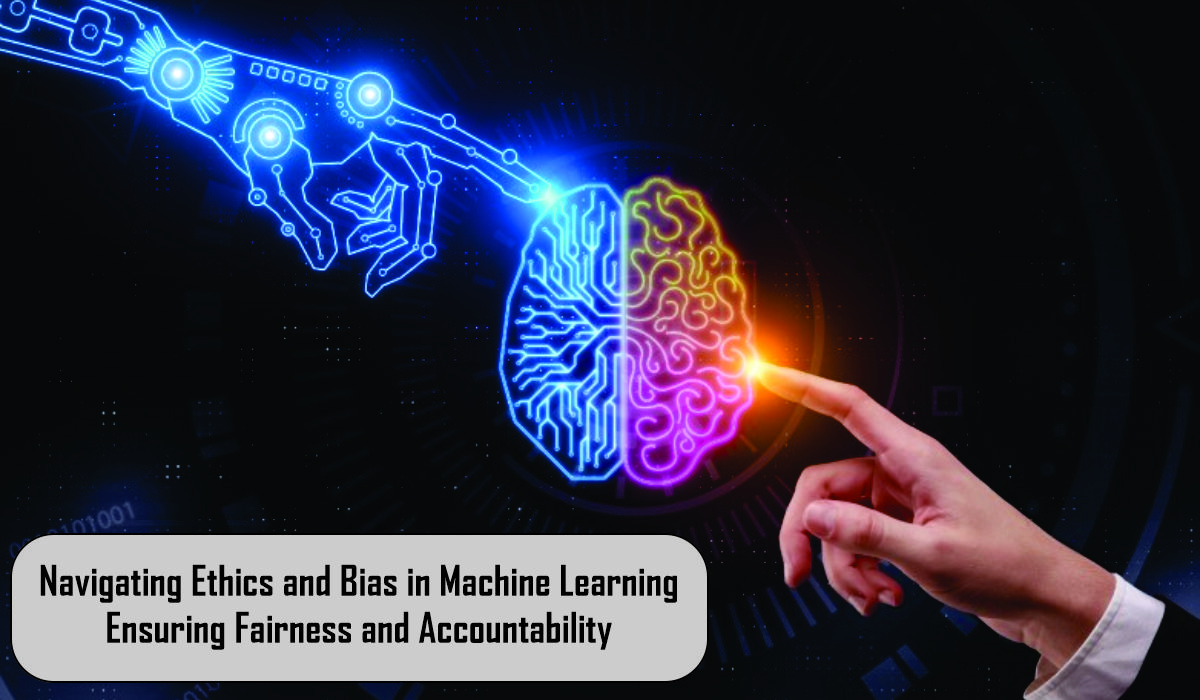Navigating Ethics and Bias in Machine Learning: Ensuring Fairness and Accountability
Navigating Fairness and Accountability in Machine Learning

In today’s world, machine learning helps us in many ways, from recommending movies to diagnosing diseases. But with great power comes great responsibility. It is important to make sure these systems are fair and just. This means we need to think about ethics and how we can avoid bias in machine learning models.
Ethics in machine learning means doing the right thing. It ensures that the technology is used in a way that is fair and doesn’t harm people. When we talk about bias, we mean unfair decisions made by machines. Bias can creep into models from the data we use or how the models are built. If not addressed, bias can lead to unfair treatment of certain groups of people. For example, a biased hiring algorithm might favor one gender over another, which is unfair.
Understanding the importance of ethics in machine learning is crucial. Without ethical considerations, machine learning systems can make unfair decisions. This can hurt people’s lives and trust in technology. By focusing on ethics, we can build fairer and more reliable systems.
Bias in machine learning models can come from various sources. It might come from the data, the algorithms, or even the people who create the models. For instance, if the data used to train a model has more examples of one group of people than another, the model might learn to favor that group.
Understanding Ethics in Machine Learning
Machine learning is a powerful tool that helps computers learn and make decisions. But, like superheroes, it must use its power for good. This is where ethics in machine learning comes in. Ethics means doing what is right and fair. In machine learning, it means creating systems that help everyone and do not harm anyone.
Ethics in machine learning is about making sure the technology is used in a way that is fair and just. It involves following key ethical principles. These principles are like rules that guide us to make good choices. One important principle is fairness. This means that the machine learning model should treat everyone equally. For example, it should not give better results to one group of people over another.
Another key principle is transparency. This means that we should understand how the machine learning system makes decisions. If we know how it works, we can trust it more. For instance, if a model decides who gets a loan, we should know why it approved or denied someone.
Privacy is also a crucial ethical principle. It means keeping people’s personal information safe and not using it without their permission. Finally, accountability is important. This means that if something goes wrong, someone should be responsible for fixing it.
Understanding ethics in machine learning helps us build better systems. By following these principles, we can create models that are fair, transparent, and respectful of privacy. This way, machine learning can be a force for good in the world.
Read Also: 8 Reasons Machine Learning Is Important For Business
Types of Bias in Machine Learning
Bias in machine learning means unfairness in how computers make decisions. Different types of bias can affect these decisions. Let’s explore each type to understand how they can happen.
Data Bias
Data bias happens when the information used to teach computers is not fair. This can happen in two main ways:
- Historical bias comes from past unfairness. If the data used to teach a computer is from a time when people were treated unfairly, the computer might learn these unfair habits. For example, if a hiring algorithm learns from old data that favored men over women, it might keep doing the same, even if it’s not fair.
- Sampling bias happens when the data collected is not a good mix of different kinds of people or things. Imagine if a computer is learning about animals but only sees pictures of dogs and no cats. It will think all animals look like dogs. This is not fair to cats!
Algorithmic Bias
Algorithmic bias happens because of how the computer program itself works. There are two main ways this can happen:
- Model bias is when the computer program makes unfair choices because of the way it was built. This can happen if the program only looks at certain things and ignores others that might be important. For example, if a loan approval program only looks at how much money someone has, it might ignore other important things like how reliable they are in paying back loans.
- Feedback loops happen when the results of the computer’s decisions make things more unfair over time. For example, if a shopping website shows more expensive items to people who click on luxury products, it might keep showing them more expensive things, even if they want something cheaper.
Human Bias
Humans can also bring bias into machine learning. This happens in two main ways:
- Implicit bias is when people don’t even realize they are being unfair. It happens because of ideas we have without knowing it. For example, if someone believes boys are better at math, they might not give girls as many chances to show how good they are.
- Confirmation bias is when people only pay attention to information that agrees with what they already think. For example, if someone believes a certain type of person is not good at sports, they might only notice when that person does badly, not when they do well.
Understanding these types of biases helps us make better computer programs. By being aware of bias and working to fix it, we can create fairer and more helpful technology for everyone.
Sources of Bias in Machine Learning
Bias in machine learning means unfairness in how the system makes decisions. This unfairness can come from different sources. Understanding these sources helps us build better, fairer systems.
One major source of bias is data collection and annotation. When we collect data to train our models, the data might not represent everyone equally. For example, if we only collect pictures of dogs but forget cats, our model will not recognize cats well. Similarly, annotation means labeling the data. If labels are wrong or biased, the model will learn from these mistakes.
Another source of bias is feature selection and engineering. Features are the pieces of information the model uses to make decisions. Choosing which features to use is very important. If we pick features that are unfair or irrelevant, our model will make biased decisions. For instance, using a person’s zip code to predict their job skills might not be fair.
Lastly, model training and evaluation can introduce bias. Training a model means teaching it to make decisions. If we use biased data during training, the model will learn these biases. Evaluation is checking how well the model works. If we use biased methods to evaluate, we will not see the real problems in the model.
Read Also: Choosing A Database for Machine Learning
Ethical Considerations in Machine Learning
When we use machine learning, we must think about doing what is right. These are called ethical considerations. They help us make sure that the technology is fair and safe for everyone.
One important part is fairness and equity. This means that machine learning should treat all people equally. It should not favor one group over another. For example, if a model helps choose students for a school, it should be fair to all students, no matter where they come from.
Another key part is transparency and explainability. This means that we should understand how machine learning makes decisions. If we know how it works, we can trust it more. For example, if a computer program decides who gets a job, we should know why it chose one person and not another.
Privacy and security are also very important. This means keeping people’s personal information safe and not sharing it without permission. For example, a health app should keep your medical information private and not share it with others without asking you.
Finally, there is accountability and responsibility. This means that if something goes wrong, someone should fix it. If a machine learning system makes a mistake, we need to know who will correct it and how. For example, if a self-driving car has an accident, the makers should be responsible for finding out what went wrong.
Strategies to Mitigate Bias in Machine Learning
When we use machine learning, we want to make sure it’s fair and helps everyone equally. Here are some ways we can make sure our computer programs don’t have unfair biases.
Data Preprocessing Techniques
Data preprocessing means getting the data ready before we teach the computer. There are two important ways to do this:
- Data augmentation is like giving the computer more examples to learn from. If we don’t have enough pictures of cats, we can make more by changing the ones we have a little bit. This helps the computer learn about all kinds of things, not just what it saw first.
- Re-sampling and re-weighting mean making sure the data we use is fair. If some groups are not represented enough, we can get more data from them or give more importance to what they have. This way, the computer learns about everyone equally.
Algorithmic Approaches
The way we write the computer program can also make a big difference in fairness. Here are two ways to do this:
- Fairness constraints are rules we write into the program to make sure it treats everyone the same. For example, we can tell it not to use information that might make it unfair, like a person’s race or where they live.
- Adversarial debiasing is like having someone check the computer’s decisions to make sure they are fair. This could be another program or a person who looks at the results to see if they treat everyone equally.
Model Evaluation and Auditing
After we teach the computer, we need to check its work to make sure it’s fair. Here are two ways to do this:
- Bias detection tools help us find out if there are unfair things in the computer’s decisions. They look at the results and see if they are fair to everyone.
- Regular audits and impact assessments mean checking the computer’s work often. We look at how it’s helping people and if there are any problems. If we find unfairness, we can fix it before it causes more problems.
By using these strategies, we can make sure our computer programs are fair and helpful to everyone. Let’s work together to make technology that treats everyone equally and makes the world a better place.
Ethical Frameworks and Guidelines
When creating machine learning systems, we need rules to follow. These rules are called ethical frameworks and guidelines. They help us make sure our technology is fair and safe for everyone.
Many organizations create these guidelines. For example, IEEE is a big group that sets standards for technology. They tell us how to make sure our machines are fair and do not harm people. The European Union (EU) also has rules for AI. Their guidelines help protect people’s rights and ensure that AI is used responsibly.
Industry best practices are another set of important rules. These are tips and methods that experts agree are the best ways to do things. They help us build better and safer AI systems. For instance, always testing our models to check for bias is a best practice.
Inclusive design is a way to make sure our technology works for everyone. It means thinking about all kinds of people, like those with disabilities when creating our systems. This way, we make sure no one is left out. Diverse development teams are also crucial. When people from different backgrounds work together, they bring many ideas. This helps us build fairer and better technology.
Conclusion
In our journey through ethics and bias in machine learning, we’ve learned important things. It’s crucial to make sure that technology treats everyone fairly. We discussed how bias can sneak into computer decisions and how ethics guide us to do what’s right.
It’s really important to use machine learning in a way that’s fair and good for everyone. By following ethical rules, we can make sure that computers make fair decisions. We want to make sure that everyone gets a chance, no matter who they are.
We should all work together to make sure that our technology is fair. If we see something unfair, we should speak up and try to fix it. Let’s make sure that everyone knows how important ethics are in machine learning. Share your thoughts below and tell us what you think! Also, share this amazing information with your friends so they can learn about it too.
It’s also good to keep learning about new ways to be fair with technology. By staying updated, we can make sure that our computers are always doing the right thing. Let’s keep working together to make technology fair for everyone!







